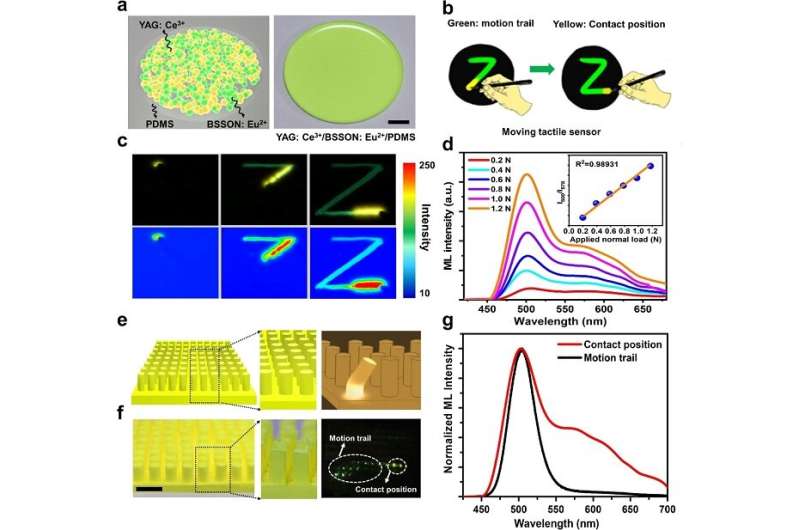The as-fabricated moving tactile sensor based on the simultaneous utilization of instantaneous and persistent ML. Credit: LICP
Mechanoluminescence (ML) is one of the oldest forms of luminescence, referring to the light emitting behaviors under the stimuli of mechanics. Since ML could directly establish the relationship between mechanics and luminescent signals, it shows enormous application prospects in mechanical sensors. However, the instantaneous emitting behavior of ML has restricted its practical applications.
Recently, Dr. WANG Zhaofeng and his research group from the Lanzhou Institute of Chemical Physics (LICP) of the Chinese Academy of Sciences (CAS), in collaboration with Dr. ZHANG Jiachi's group at Lanzhou University (LZU) and Dr. SUN Luyi's group at the University of Connecticut, have developed two kinds of high performance ML materials, namely YAG: Ce3+ and BSSON: Eu2+, exhibiting instantaneous yellow ML and persistent green ML, respectively.
"The green ML phenomenon could last over ten seconds. It provides us more opportunities to develop intriguing devices that are closer to the practical applications," said Dr. WANG.
By ingeniously combining the unique ML behaviors of the two materials, they further developed a tactile senor that could simultaneously sense/record the contact load, motion trail, and contact position for objects moving on the device surface.
"This is the first time to present application designs by simultaneously utilizing transient and persistent ML. For previous tactile sensors, they need to be integrated on a circuit board to achieve those functions. We are very happy to find that our ML tactile sensor got it in a single sensor without any extra circuit design. Such kind of sensor could be applied in mechanics monitoring, human-machine interfacing, intelligent artificial skin, and other related fields." Dr. WANG explains.
These findings are described in the article entitled "Mechanics-induced triple-mode anticounterfeiting and moving tactile sensing by simultaneously utilizing instantaneous and persistent mechanoluminescence" published in the journal Materials Horizons.
Provided by Chinese Academy of Sciences






















